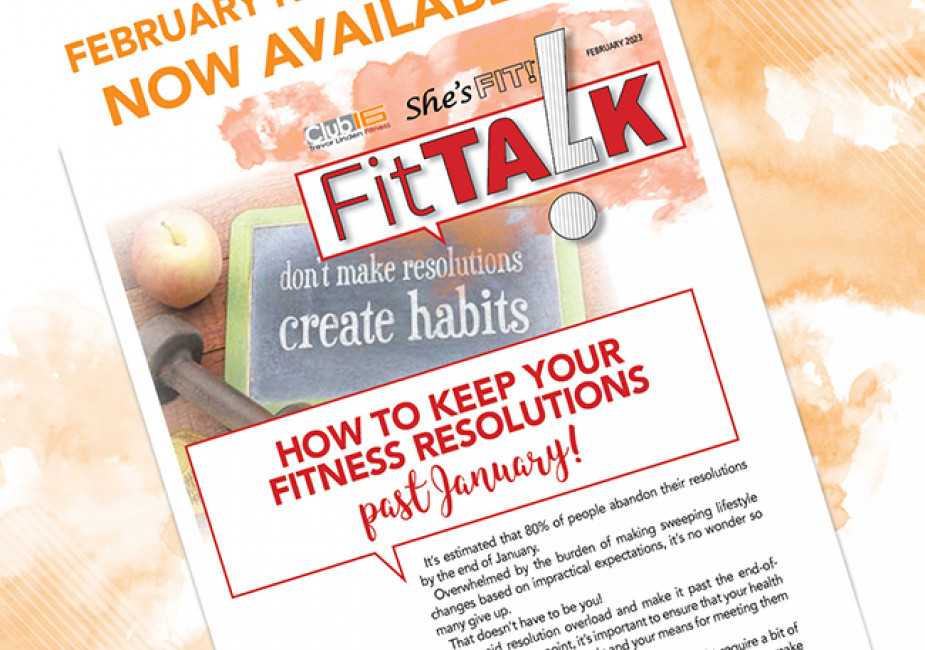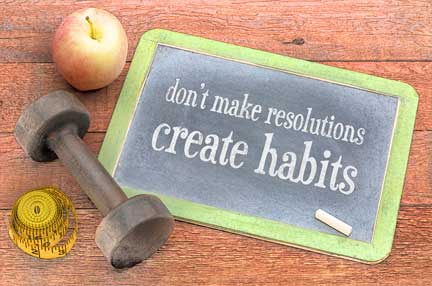Make nondisruptive changes to existing habits.
Too often, we structure our resolutions in ways that require major changes to established, everyday habits. For instance, getting up an hour earlier to work out each day might not sound like a huge life disruption. But if you’ve been waking up at 7 a.m. every day for the past 20 years, just the act of awakening an hour earlier is going to be a struggle — never mind also getting yourself to workout. We’re not saying it’s impossible. However, let’s be realistic about the difficulty level of resolutions we set in the context of our ingrained habits.
For instance, if you’re a daily coffee drinker who uses cream and sugar, could you decrease the amount you use, or try replacing the cream or sugar with a healthier alternative? Imagine replacing a teaspoon of sugar in your coffee with a sprinkle of antioxidant-rich cinnamon. Averaging two cups of coffee a day, that means you will avoid ingesting 7,300 teaspoons of sugar in a decade! That’s a small change with a big long-term return.
You can also make nondisruptive habit changes with habit stacking, a practice that involves adding a new healthy habit right before, during or directly after one of the ingrained habits you automatically do daily, like brushing your teeth or showering.
Focus on what you’re already doing right — and do more of it.
There is a tendency with resolutions to focus on fixing what we feel we’re doing wrong, like “not exercising enough” or “eating too many snacks.” But when we look at what we’re already doing right and strive to do more of it, that change in perspective can accomplish the same goal in a much more positive and sustainable way.
Think about how often you take a walk. Maybe you already have a daily walking habit either by yourself or walking your dog. Could you extend your walking time by a few minutes? Those extra minutes will add up.
Maybe you don’t have a regular walking habit. That’s OK. Think about any of the necessary times each day you have to walk a distance and get creative about ways to extend it. This could be as simple as taking a parking spot further from your office if you drive to work. Or maybe there is a flight of stairs in your home or office. What if at least once per day, you doubled back and did the stairs twice? Remember, don’t discount the value of making small changes; they add up to bigger returns over time.
How’s your water intake? Drinking water is important for our overall health and can also increase feelings of fullness to help us avoid unplanned snacking. I’m sure you’re already drinking some, but could you increase it? It’s recommended that women drink 72 ounces of water daily; men should drink 100 ounces. Consider the suggestion from the previous tip and swap out another not-as-healthy beverage you already drink daily to increase your water intake.
Keep track of your health and fitness-related activities.
It’s easy to let things slide when no one else is watching. But when we track our activity, we’re taking an extra step in personal accountability that makes us feel like “someone” is watching. Whether it’s a smartphone app, watch, ring or even just a notebook, it tends to embody a bit of our conscience.
Accountability is arguably one of the most significant factors in ensuring you stick to your health and fitness resolutions. That’s why fitness trackers are so effective. In fact, people walk almost an extra mile per day when using an activity tracker on their phone or watch, according to a recent study published in the British Journal of Sports Medicine.
In addition to the accountability factor, fitness trackers also take advantage of our competitive nature by inciting us to do more. The BJSM study authors found that the participants in the study did better when their fitness trackers provided prompts.
Regardless of how you track your fitness — using a wearable technology, an app on your phone or simply keeping a journal — it will inevitably help keep your health and fitness resolutions on track.
Invest in positive health changes.
Making a resolution that involves investing in a way to increase your health and fitness is arguably one of the easiest ways to make a sustainable resolution. Of course, like any other resolution, it’s only sustainable if your purchase realistically fits your lifestyle and doesn’t require an overly ambitious commitment.
Sleep facilitators: When health and fitness are priorities, sleep should be as well. During sleep our body focuses on recovery, which is why sleep takes up nearly one-third of our lives. To enhance our ability to get quality sleep, we can invest in any number of products to help us sleep better, like ergonomic pillows or a higher-quality mattress to increase comfort, a sound machine to help us fall asleep or climate control mattress pad to help us stay asleep.
Fitness-conscious furniture: You’ve probably heard that sitting is as bad as smoking when it comes to our health so it’s important to try and offset our sitting time. Investing in a standing desk is a great way to avoid prolonged bouts of sitting. Additionally, swapping out your desk chair for an exercise ball — a much less-expensive investment — can make your sitting time more active and less sedentary.
Personal training sessions: People work with personal trainers for many reasons. Whether you want to develop an individualized program to support weight loss goals, get in shape, or feel that you’d benefit from the additional accountability or instruction, a personal trainer can be a great resource.
But sometimes, people are cautious about investing in a trainer. Cost can be an issue; some people might feel intimidated by working with a pro. But certified fitness professionals are trained to work with clients of all backgrounds and fitness levels. And we ensure to work out package deals to make our personal training services more affordable.
If you are starting an exercise program or don’t see results with your current routine, a personal trainer might be your best option. Try our personal training services by booking a free personal fitness consultation session online on our website or in person at any of our locations.
Change your resolution mantra.
Now that you’re armed with the knowledge and strategies to restructure your health and fitness resolutions for long-term success, it’s time to set a new resolution mantra, and go with something more appropriate, one like: “simple sustainable steps for a happier, healthier you.”










